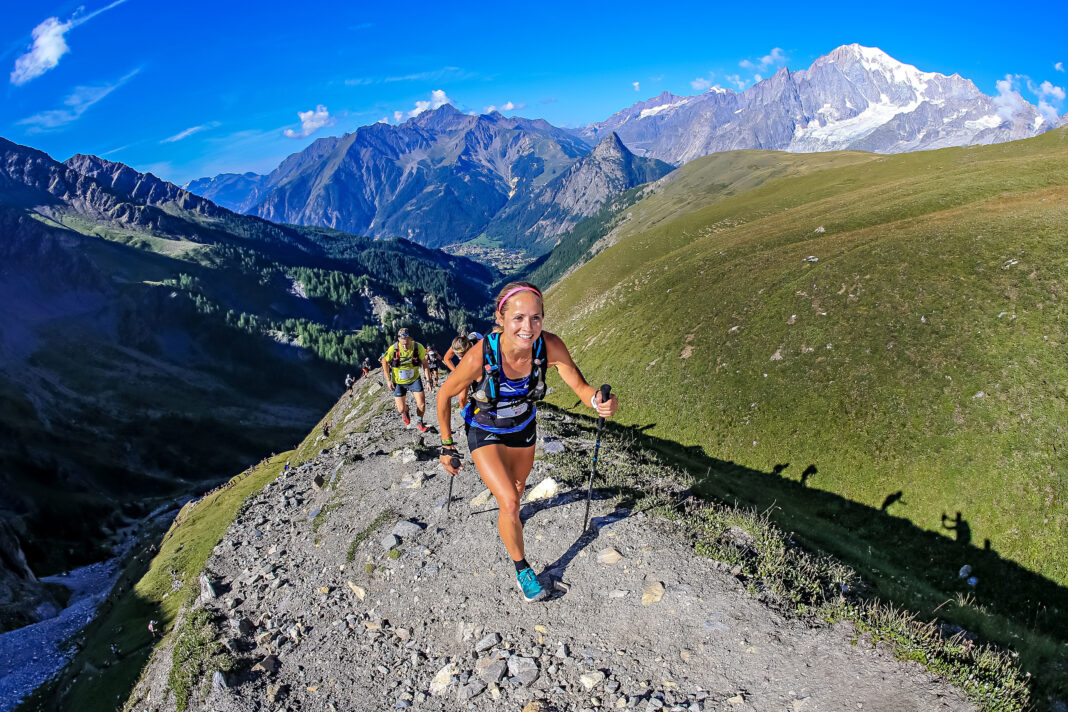Do you see the upcoming hill ahead of you and feel the wind blow out of your sails? Do you ride the brakes down a steep descent and wonder how someone else is floating past you? If so, you are not alone in feeling like uphill and downhill running are still mysteries that you have yet to master.
Uphill running includes a variety of skill sets, including strength, power, stamina and mental fortitude. Downhill running capitalizes on a whole different set of skills such as agility, durability, stability and mental focus, or what may appear to be guts, bravery or even a bit of senselessness. Avoiding this type of terrain can make you miss out on some of the most beautiful places on earth and there are some simple means of gaining confidence in the mountains.
Uphill Running Recommendations
- Lean forward at the ankles and drive from the glutes
- Use a run-walk combination approach
- Practice your hiking skills
Proper uphill running form includes a slight forward lean and driving forces starting at your feet and working through the entire posterior kinetic chain. You want the forward lean to be at the ankles rather than your hips. A strong “toe off” with maximal force through the calves, while activating your glutes will power you up that hill. Activate your lower core to stabilize your pelvis and utilize your glute muscles.
You become more anaerobic with uphill running meaning your breathing becomes more laboured. If you push too much, too soon, it could compromise your energy levels and efficiency later in your run or race. Think of it as finding the “just-right challenge,” which tends to coincide with a “run-hike” combination approach.
You never want to be too uncomfortable or too comfortable when running uphill. To maximize running economy, practice running until you recognize that you are pushing too far into an anaerobic level and then back off into hiking to restore more aerobic levels. This “hiking with intention” can get into a solid rhythm while allowing the heart rate to lower. Once you feel somewhat comfortable again, resume running, and continue the pattern. Pro tip: Fuel, fuel, fuel during these cycles!
Practising hiking skills may not seem as glorious as doing hill repeats and pushing all the way up the hill without having to walk, but just as practising running and form is required, so too is practising hiking. Becoming efficient mechanically and aerobically while hiking can be a secret weapon to enduring tough mountain terrain, no matter the distance.
Downhill Running Recommendations
- Strengthen your quads and stabilizers
- Lengthen your stride or quick feet
- Look ahead
- Stay relaxed
Downhill should be the “easier” or “more fun” part of running, but it is often a source of stress or an area where one feels deficient. Rather than feeling free on the downhill, you’re riding the brakes, feeling out of control, or feeling like you’re tiptoeing down the trail. Downhill running requires eccentric acceptance of force and can easily promote injuries if we don’t properly train our bodies to accept this load.
Strength training prepares your body to hammer the downhills. This can be done in a traditional sense at the gym with squats, lunges, and deadlifts, but run training can also be tailored to condition your body to handle the load that comes with significant downhill running.
Strengthening the major muscle groups in your legs will help prevent injury, but it is also essential to think about our lower legs and feet when considering downhill running. Ankle stability, foot mechanics and strength are where accepting the eccentric load of downhills begin, and can promote durability as well as add efficiency and adaptability on more varying terrains (i.e. cambered slopes, rocky or uneven surfaces).
Stride length and technique are also things to consider, which correlates with the type of terrain you are running. A smooth, buffed-out trail is an opportunity to lengthen your stride and relieve some of the burning in the quads as you use gravity to float downhill. In contrast, if it is steep or rocky technical terrain, shorter strides and quicker feet is advised.
This terrain demands focus and quick thinking. A runner should be looking ahead, planning foot placement to promote best footing with these quick, potentially shorter stride lengths on this type of downhill.
Finally, stay as relaxed as you can on the downhills. Ensure you are taking deep breaths and keeping your upper body relaxed. While you learn to trust your instincts, your body, and your footing, you will learn to enjoy those downhills.
With these pointers, you can now get out on the trail and look ahead to the ups and the downs of running. Welcome the burn, find the thrills and relish the progress as you chase your goals.
Feature photography by Miguel Marote Henriques/Trail-Running.pt
You may also like: Trail Running 101

Read This Story in Our 2023 Summer Outdoor & Travel Issue
Featuring Alison Jackson, Canadian cyclist and only North American male or female to win the famed Paris Roubaix. Travel the country’s most stunning hot spots by campervan. Become a better trail running by improving your ascents and descents—plus, train outdoors with Canada’s Top Fitness Trainers. Enjoy plant-based summer recipes and so much more.

















